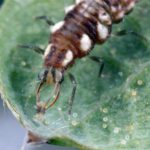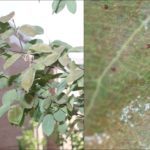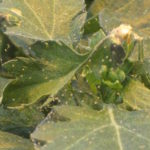What are spider mites? Spider mites are small 8 legged creatures that are more closely related to common house spiders than insects. They injure plants by puncturing the surface of plant tissue and lapping up the fluid that comes bubbling out. Although they are individually difficult to see with the naked eye, they make up for their small size by their ability to rapidly increase their numbers. Heavy feeding by large numbers of mites can discolor plant leaves and cause them to drop prematurely. Some species even cover plants with a fine webbing. Most common trees, shrubs and flowers are susceptible to injury by one or more species of spider mites. Two spotted spider mites feed on a wide variety of plants. Their capacity to injure plants is representative of other species.

Reduce pesticide use to encourage predators like this lacewing larva to eat your spider mites (Photo by L. Buss, U. Fla)
Why are spider mites a problem now at this time of year? Most species of spider mites, like the heat. Indeed the egg of a two spotted spider mite can produce another egg laying female is a little at 5-7 days when temperatures are above 80˚ F and humidity is low (< 40%). With each female producing up to 100 eggs, warm and dry conditions can set the stage for a population explosion in the heat of summer. Spruce trees, and rhododendrons and some other broad leaf evergreens lack spider mite problems this time of year because the spider mites that attack them thrive in cooler temperature.
Both warm and cool season spider mites do best in the absence of rain when humidity is low because rainfall can knock some mites off of plants, and many species of mites are attacked by fungi during periods of high humidity.
Use of some insecticides, like neonicotinoids, carbaryl and pyrethroids against some early season pests, like Japanese beetles and defoliating caterpillars and aphids can kill the predatory mites and other insects that also work to keep spider mites under control. This year’s outbreaks of spongy (previously gypsy) moth, Japanese beetles and bagworm was likely to prompt enough insecticide sprays to wipe out predators and set the stage for late season mite problems.
Inspect your plants for spider mites. Look for plants that begin to fade in color and appear as if covered in dust or appear bronze or covered in webs.
- Serviceberry leaves attacked by European red mite appear bronzed (left), and are covered with egg shells, and old spider mite skins (right).
- Chrysanthemum covered with fine webs and small spider mites (Photo by R. Lopez, Mich. State).
- Professionals or garden enthusiasts could tap a dry branch over a white sheet of paper to look for mites. You will probably need a magnifying lens to see the mites.
How to control spider mites
If you just have one or two affected plants or small parts of a plant affected, consider pruning or removing the infested part and spraying the remaining plant parts with a strong shower of water from your garden hose. This will knock off some mites, and if you do it repeatedly over a week or two, it could encourage the growth of a fungus that kills spider mites. But, be careful. Having water on the leaves for a long period of time is not a good idea for those plants that are prone to leaf diseases.
Apply a solution of 2% insecticidal soap, horticultural oil, or neem oil to kill spider mites if hosing down your leaves is not an option for your plants.
If your plant is dripping with mites and webs and all else has failed, you can use a miticide. Homeowner products with the active ingredient bifenthrin can kill spider mites and hold them back for as long as a month before the spider mite population comes back. Professionals have a wider choice of products to choose from. For more information on specifics see our bulletin on managing spider mites in the urban landscape.


